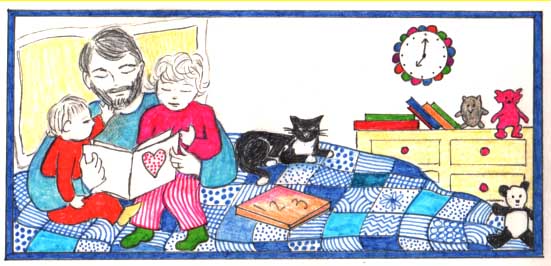I admire Judith Kerr’s realism. This may seem a strange
thing to say of the woman who in 1968 wrote The
Tiger Who Came to Tea, in which a tiger rings the doorbell, is invited
inside by a young girl and her mother, eats all the food, drinks all the beer
and leaves, and then father comes home from work, sees the destruction and cheerily says no worries girls, let’s just go out for dinner. I guess even
children’s books were on hallucinogens in the late ’60s.
But when it comes to domestic cats, Judith Kerr knows her stuff. Mog is stupid,
forgetful, lazy, easily frightened, and selfish. Let me run through that checklist with our cat, Ruby. Tick, tick, tick, tick, tick. Mog is so
realistic it’s a wonder we never see her licking her anus. Mog
even dies in the final book in the series, written 22 years after the first – despite
her flaws, I hope we have that long with Ruby.
And so this festive season, what better book for DadReads
than Mog’s Christmas? When I was a
kid, Mog’s Christmas was a fixture of
the holiday season. It wasn’t my favourite Christmas book – that was Lucy and Tom’s Christmas by Shirley Hughes.
Maybe I related to it less because we didn’t have a pet cat. But I still
enjoyed it. Now, as a cat owner, Mog’s
Christmas resonates.
It’s nearly Christmas in the Thomas household, and
everybody is busy:
Mog doesn’t like strangers visiting, so she hides
outside. Ruby doesn’t like strangers visiting; she usually squeezes herself
under the coffee table and waits until the coast is clear. In fact, Ruby doesn’t like anyone getting right up in her face. As well as a cat owner, I’m a
baby owner, and Heidi enjoyed Mog’s
Christmas so much that she tried to “read” it to Ruby by shoving it in
front of her face. Good intentions, but Ruby scarpered.
Suddenly she woke up. She saw something. It was a tree. It was a tree walking. Mog thought, “Trees don’t walk. Trees should stay in one place. Once trees start walking about anything might happen.” She ran up the side of the house in case the tree should come and get her. “Come down,” shouted the tree. “Come down, Mog!” “First it walks,” thought Mog, “and now it’s shouting at me. I do not like that tree at all.”
Mog thinks that the Christmas tree is walking because Mr
Thomas is carrying it towards the house. Are cats that stupid? The first Christmas we had Ruby, she
was exactly the same when I brought our Christmas tree inside. She ran away and
hid. But then she got used to the tree and spent the next month eating pine
needles and throwing them back up. Spiky? Yes. Indigestible? Yes. But damn they
taste good. I guess anything would, compared to her own anus.
To be fair to Ruby, Heidi also had Christmas tree "issues". When we collected it from the local Rotary
Club a few weeks ago and shoved it in the car, Heidi was a blubbering mess. Mog
only had to see a tree walking. Heidi had to share the back seat of the car
with one. She didn’t handle it well. If trees shouldn't walk, they definitely shouldn't go cruising in a Volkswagen Polo.
Anyway, Mog retreats to the roof. It starts snowing, but
Mog is stubborn, and won’t come down. She goes to sleep on top of the chimney
and then as the snow melts underneath her, she plummets down through the soot and
lands in the fireplace. Her timing is fortuitous; one page earlier, Mrs Thomas
was stacking logs in the fireplace, preparing to light them. It was nearly roast cat for Christmas dinner.
When Mog lands in the living room, one of the senile aunts
cries “It’s Father Christmas!” “No, dear,” says the other aunt. “Father
Christmas does not have a tail.” This, I think, is evidence that the aunts are
blood relatives of Mrs Thomas, who displayed a tenuous grasp on reality in Mog and the Baby.
All’s well that ends well, and Mog’s Christmas finishes with everyone standing around the
Christmas tree unwrapping presents. At least, I hope that’s what’s happening,
because one of the senile aunts is holding a pair of pantyhose. If she hasn’t
just unwrapped them, she’s taken them off, and the daft smile on her face makes
me wonder which it is.
Mog’s creator Judith Kerr, now 93, has had an interesting
life. Her father Alfred Kempner (he later changed his name to Kerr) was a
well-known German theatre critic nicknamed the Kulturpapst, or “Culture Pope”.
Judith was born of Jewish origin in Germany in 1923, not an ideal time to be
born of Jewish origin in Germany, and the family moved to Britain when she was
10.
As of last year, she was still publishing new works – Mog’s Christmas Calamity was the latest. I haven’t read it, but maybe the calamity was that the Thomases only just realised Mog had been dead for 13 years. Given Mrs Thomas’
absent-mindedness – in Mog and the Baby she
lets a neighbour’s child escape the house and run into oncoming traffic – this would
not be a surprise. If you told me Mrs Thomas had been feeding Mog’s corpse
since 2002, I’d believe you.
On that bright note, Merry Christmas from DadReads.













